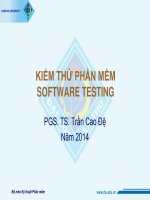Bài giảng Kiểm thử phần mềm: System devolopment life cycle - ThS. Nguyễn Thị Thanh Trúc
Bạn đang xem bản rút gọn của tài liệu. Xem và tải ngay bản đầy đủ của tài liệu tại đây (14.47 MB, 20 trang )
University of Information Technology
Lecture: MSc. Nguyen Thi Thanh Truc
Email:
CuuDuongThanCong.com
/>
•
•
•
•
SDLC & Testing
SDLC Models
Reasons for using SDLC Models
Advantages of choosing an appropriate SDLC
Model.
CuuDuongThanCong.com
/>
•
•
•
•
SDLC & Testing
SDLC Models
Reasons for using SDLC Models
Advantages of choosing an appropriate SDLC
Model.
CuuDuongThanCong.com
/>
• SDLC
– Stands for System Development Life Cycle
– Be a framework that describe phase of software
cycle and the order in which those phases are
executed.
– Each phase produces deliverables required by the
next phase in the life cycle.
CuuDuongThanCong.com
/>
CuuDuongThanCong.com
/>
• Requirement gathering and analysis.
CuuDuongThanCong.com
/>
• Requirement gathering and analysis.
CuuDuongThanCong.com
/>
• Requirement gathering and analysis.
– Main focus of project managers and stakeholders.
– Meeting with managers, stakeholders and users to
determine the requirements.
– Outputs:
•
•
•
•
•
Project Mananagement Plan
Functional Requirements
Technical Requirements
Requirement Review and Approval
Statement of Work
CuuDuongThanCong.com
/>
• Design.
– System and software design is prepared from the
requirement specifications.
– System Design helps in specifying hardware and
system requirements
– Define overall system architecture.
– Outputs
•
•
•
•
High Level Design (HLD)
Low Level Design (LLD)
Design Review
Detailed Project Development.
CuuDuongThanCong.com
/>
• Implementation & Coding.
– From system design documents, the work is
divided in modules/units
– Actual coding is started
– Main focus for the developer.
CuuDuongThanCong.com
/>
• Integration & Testing.
– After the code is developed, it is tested against the
requirements,
– All types of functional testing like unit testing,
integration testing, system testing, acceptance
testing are done
– Non - functional testing are also done.
CuuDuongThanCong.com
/>
• Installation & Deployment.
– After successful testing the product is
delivered/deployed to the customer for their use.
– Customers will first do the beta teting. bug are
caught and report to the engineering team.
– Bugs fixed final deployment will happen.
CuuDuongThanCong.com
/>
• Maintenance
– Customers start using the developed system
actual problems come up needs to be solved
from time to time.
CuuDuongThanCong.com
/>
•
•
•
•
SDLC & Testing
SDLC Models
Reasons for using SDLC Models
Advantages of choosing an appropriate SDLC
Model.
CuuDuongThanCong.com
/>
• To help understand and implement the SDLC
phases, various SDLC models have been
created by software development experts,
universities and standard organizations.
• Some famous SDLC
– Waterfall model
– Spiral Model
– V - model
– Agile Model
– ….
CuuDuongThanCong.com
/>
•
•
•
•
SDLC & Testing
SDLC Models
Reasons for using SDLC Models
Advantages of choosing an appropriate SDLC
Model.
CuuDuongThanCong.com
/>
• Provides basis for project planning, estimating
& scheduling.
• Provides framework for standard set of
terminologies, activities & deliverables
• Provides mechanism for project tracking &
control.
• Increases visibility of project progress to all
stakeholders.
CuuDuongThanCong.com
/>
•
•
•
•
SDLC & Testing
SDLC Models
Reasons for using SDLC Models
Advantages of choosing an appropriate SDLC
Model.
CuuDuongThanCong.com
/>
•
•
•
•
•
•
Increased development speed
Increased product quality.
Improved tracking & control
Improved client relations
Decreased project risk
Decreased project management overhead.
CuuDuongThanCong.com
/>
CuuDuongThanCong.com
/>









